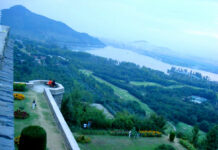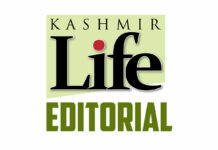It has been more than a year since Prime Minister Narendra Modi found Dal Lake, Jhelum and Srinagar converted into a little ocean. It was the worst instance of Kashmir’s urban flooding that now stands listed as the World’s worst economic disaster for 2014. Though the author of the report, appeared in US’s Annual Disaster Statistical Review, has misreported its location as ‘Jammu’, it does not reduce the magnitude of the crisis it has detailed. Reports puts the losses at US 16 billion dollars (Rs 104000 crore), slightly more than J&K’s government’s evaluation.
Post-disaster, the verbal response of the state and central government’s has remained positive. In action, however, it has been pathetic. Apart from around Rs 1800 crore claims that various insurance agencies paid, the overall capital infusion from all sources has not been more than Rs 5000 crore. For a state whose own narrow resource base was impacted by floods seriously, central government should have been faster in recapitalizing the market and the treasury with adequate liquidity. Even banks which had announced certain interest subventions, are now desperate to see which government funds that petty concession, how and when? RBI is now considering a yearlong extension on that.
While the markets seemingly whitewashed and reopened to keep the show going, the picture-perfect outlook misreported the crisis that still prevails around. Fall in the tourist footfalls contributed negatively on a small consumer economy that had most of the harvest inundated. Liquidity crunch has slowed down the economic wheel already.
After series of talks at different levels, the state and the central government have arrived at some consensus on numbers and mechanisms. Both the parties are finding their way to sell the ‘package’ that J&K has been hearing for a very long time now. They may have issues and they might be trying to solve them but it entails a bigger cost for the people waiting for some succour.
Flood impacted population managed last winter under donated blankets, behind swollen wood-doors, rusting walls and moist floors. The desperate requirement for capital to rebuild homes is still being felt as autumn chill is the new dusk-to-dawn routine.
For helping an economy to restore post-disaster is routinely a priority for any governance structure. It is assumed Delhi has it too. The last impressive precedence was the rebuilding of the earthquake-devastated Uri and Karnah towns near the LoC.
But different parties may have different versions of the governance. For ruling BJP, there might be another model of rebuilding Kashmir with focus on encouraging the devastated lot to stand up on their own legs with their own strength. This, in principle, is organic and natural albeit primitive. But a model it is. The loud-thinking in Kashmir is that it was this model in action when Delhi refused any international relief earlier.
The only issue that governments in Delhi and Srinagar must tell people that no help is under way. This will burst the possible-hope balloon and force people to look at their inherent strengths. This will send people revisiting the 1905 story when a similar flood hit the same streets in Srinagar. Then, Kashmir was ruled by autocrats which BJP, 100 years later, believes were model rulers. As people were seeking help, Maharaja’s family ensured no pilferage from the treasure that was amassed with the sweat and blood of Kashmirs’ since 1846. If Kashmir could survive then, it can survive now.









